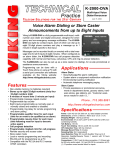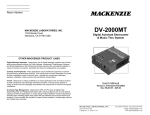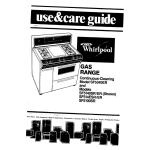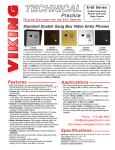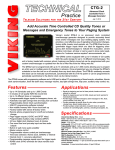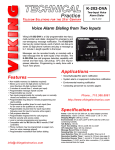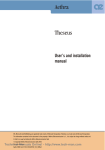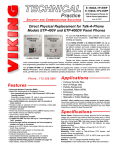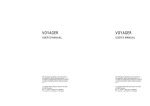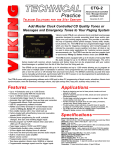Download Viking K-2000-DVA Specifications
Transcript
TECHNICAL
Practice
TELECOM SOLUTIONS
Practice
FOR THE
K-2000-DVA
Multi-Input Voice
Dialer/Announcer
2 1 S T C E N T U RY
May 28, 2009
Voice Alarm Dialing or Store Caster
Announcements from up to Eight Inputs
Viking’s K-2000-DVA is a fully programmable multi-input, multinumber auto dialer and digital announcer, designed for emergency and non-emergency message notification. The K-2000DVA has eight dry contact inputs, each of which can dial up to
eight 32-digit phone numbers and play a message up to 1 minute
in length specific to that input.
Messages can be recorded locally or remotely with a total message time for all 8 inputs of eight minutes. When configured as
an alarm dialer, the K-2000-DVA has call progress detection
capability with normal and fast busy, call pickup, CPC and ringno-answer detection. The K-2000-DVA can also be set up as a
store caster (no dialing), for on-site promotional or assistance
announcements.
Programming can be done with a touch tone
phone or using a PC with a serial port connection and free software available on the
Viking website: www.vikingelectronics.com
Features
• Non-volatile memory (no batteries required)
• Stores up to eight 32-digit phone numbers (sixty-four
32-digit numbers total)
• 8 minutes of record time (1 minute per input)
• Programmable message repeat counter
• Programmable lap counter
• Eight inputs programmable normally open or normally
closed and enabled or disabled
• Programmable ring delay for remote programming and
alarm polling
• Programmable qualifier timer for each input (time
for an event to be qualified as an alarm)
• Programmable resume timer for each input (time
following reset for input to become active again)
• Call progress detection
• Programmable ringback limit for call progress
• Remote security and access codes
• Store caster mode
• Local or remote programming and recording
• RS-232 port for programming via a PC
• Compatible with the RC-2A and RC-3 remote DTMF
controllers
• Phone numbers may be programmed as pager
numbers (no voice message played)
• Programmable hookswitch flash before dialing
• Line level input for loading pre-recorded messages
into the unit
Applications
Alarm Dialer
• Security/burglar/fire alarm notification
• System alarm or equipment malfunction notification
• Environmental warning notification
• Contacting personnel via numeric pagers
Store Caster
• Provide assistance or promotional announcements in department stores, grocery stores, hardware stores, gas stations, etc. “Customer assistance needed in aisle 13...”
Phone...715.386.8861
h t t p : / / w w w. v i k i n g e l e c t r o n i c s . c o m
Specifications
Power: 120V AC/12V DC 500 mA, UL listed adapter provided
Dimensions: 211mm x 160mm x 46mm (8.3” x 6.3” x 1.8”)
Shipping Weight: 1.02 Kg (2.25 lbs)
Environmental: 0°C to 32°C (32°F to 90°F) with 5% to 95% noncondensing humidity
Talk Battery: 12V DC
Touch Tone Dialing: 120 ms on/off, 50 ms on/off
CPC Detection Time: 320 ms minimum
Message Record Time: 8 minutes
Sampling Rate: 64 K (equivalent)
Input Detection Time: 80 ms with Qualifier Timer set to 0
Resolution Qualifier Timer: 1 second to 18 hours (see page 3)
Resolution Resume Timer: 1 second to 18 hours (see page 3)
Connections: (1) RJ11 jack for telco connection, (2) 3.5mm
jacks for 600-ohm audio output and record in, (1) 9 pin RS-232
for PC connection, (1) 12 position screw terminal block for inputs
IF YOU HAVE A PROBLEM WITH A VIKING PRODUCT, PLEASE CONTACT: VIKING TECHNICAL SUPPORT AT (715) 386-8666
Our Technical Support Department is available for assistance weekdays between 8 a.m. and 5 p.m. central time. So that we can give you better service, before you call please:
1. Know the model number, the serial number and what software version you have (see serial label).
2. Have your Technical Practice in front of you.
3. It is best if you are on site.
RETURNING PRODUCT FOR REPAIR
RETURNING PRODUCT FOR EXCHANGE
The following procedure is for equipment that needs repair:
1. Customer must contact Viking's Technical Support Department at 715-386-8666 to obtain a Return Authorization (RA)
number. The customer MUST have a complete description of the problem, with all pertinent information regarding the
defect, such as options set, conditions, symptoms, methods to duplicate problem, frequency of failure, etc.
2. Packing: Return equipment in original box or in proper packing so that damage will not occur while in transit. Static
sensitive equipment such as a circuit board should be in an anti-static bag, sandwiched between foam and individually boxed. All equipment should be wrapped to avoid packing material lodging in or sticking to the equipment. Include
ALL parts of the equipment. C.O.D. or freight collect shipments cannot be accepted. Ship cartons prepaid to:
Viking Electronics, 1531 Industrial Street, Hudson, WI 54016
3. Return shipping address: Be sure to include your return shipping address inside the box. We cannot ship to a PO Box.
4. RA number on carton: In large printing, write the R.A. number on the outside of each carton being returned.
The following procedure is for equipment that has failed out-of-box (within 10 days of purchase):
1. Customer must contact Viking’s Technical Support at 715-386-8666 to determine possible causes for the problem. The
customer MUST be able to step through recommended tests for diagnosis.
2. If the Technical Support Product Specialist determines that the equipment is defective based on the customer's input
and troubleshooting, a Return Authorization (R.A.) number will be issued. This number is valid for fourteen (14)
calendar days from the date of issue.
3. After obtaining the R.A. number, return the approved equipment to your distributor, referencing the R.A. number. Your
distributor will then replace the product over the counter at no charge. The distributor will then return the product to
Viking using the same R.A. number.
4. The distributor will NOT exchange this product without first obtaining the R.A. number from you. If you haven't
followed the steps listed in 1, 2 and 3, be aware that you will have to pay a restocking charge.
LIMITED WARRANTY
Viking warrants its products to be free from defects in the workmanship or materials, under normal use and service, for a period of one year from the date of purchase from any authorized Viking distributor or 18 months from the date manufactured, which ever is greater. If at any time during the warranty period, the product is deemed defective or malfunctions, return the product to Viking Electronics, Inc., 1531 Industrial Street, Hudson, WI., 54016. Customer must contact Viking's
Technical Support Department at 715-386-8666 to obtain a Return Authorization (R.A.) number.
This warranty does not cover any damage to the product due to lightning, over voltage, under voltage, accident, misuse, abuse, negligence or any damage caused by use of the product by the purchaser or others.
NO OTHER WARRANTIES. VIKING MAKES NO WARRANTIES RELATING TO ITS PRODUCTS OTHER THAN AS DESCRIBED ABOVE AND DISCLAIMS ANY EXPRESS OR IMPLIED WARRANTIES OR MERCHANTABILITY OR FITNESS FOR ANY PARTICULAR PURPOSE.
EXCLUSION OF CONSEQUENTIAL DAMAGES. VIKING SHALL NOT, UNDER ANY CIRCUMSTANCES, BE LIABLE TO PURCHASER, OR ANY OTHER PARTY, FOR CONSEQUENTIAL, INCIDENTAL, SPECIAL OR EXEMPLARY DAMAGES ARISING OUT OF OR RELATED TO THE SALE OR USE OF THE PRODUCT SOLD HEREUNDER.
EXCLUSIVE REMEDY AND LIMITATION OF LIABILITY. WHETHER IN AN ACTION BASED ON CONTRACT, TORT (INCLUDING NEGLIGENCE OR STRICT LIABILITY) OR ANY OTHER LEGAL THEORY, ANY LIABILITY OF VIKING SHALL
BE LIMITED TO REPAIR OR REPLACEMENT OF THE PRODUCT, OR AT VIKING'S OPTION, REFUND OF THE PURCHASE PRICE AS THE EXCLUSIVE REMEDY AND ANY LIABILITY OF VIKING SHALL BE SO LIMITED.
IT IS EXPRESSLY UNDERSTOOD AND AGREED THAT EACH AND EVERY PROVISION OF THIS AGREEMENT WHICH PROVIDES FOR DISCLAIMER OF WARRANTIES, EXCLUSION OF CONSEQUENTIAL DAMAGES, AND EXCLUSIVE REMEDY AND LIMITATION OF LIABILITY, ARE SEVERABLE FROM ANY OTHER PROVISION AND EACH PROVISION IS A SEPARABLE AND INDEPENDENT ELEMENT OF RISK ALLOCATION AND IS INTENDED TO BE ENFORCED
AS SUCH.
FCC REQUIREMENTS
This equipment complies with Part 68 of the FCC rules. Located on the equipment is a label that contains,
among other information, the FCC registration number and ringer equivalence number (REN). If requested, this
information must be provided to the telephone company.
The REN is used to determine the quantity of devices which may be connected to the telephone line.
Excessive REN's on the telephone line may result in the devices not ringing in response to an incoming call. In
most, but not all areas, the sum of the REN's should not exceed five (5.0) To be certain of the number of devices
that may be connected to the line, as determined by the total REN's, contact the telephone company to determine the maximum REN for the calling area.
This equipment cannot be used on the telephone company-provided coin service. Connection to Party Line
Service is subject to State Tariffs.
If this equipment causes harm to the telephone network, the telephone company will notify you in advance
that temporary discontinuance of service may be required. If advance notice isn't practical, the telephone company will notify the customer as soon as possible. Also, you will be advised of your right to file a complaint with
the FCC if you believe it is necessary.
The telephone company may make changes in its facilities, equipment, operations, or procedures that could
affect the operation of the equipment. If this happens, the telephone company will provide advance notice in
order for you to make the necessary modifications in order to maintain uninterrupted service.
If trouble is experienced with this equipment, please contact: Viking Electronics, Inc., 1531 Industrial
Street, Hudson, WI 54016 (715) 386-8666
If the trouble is causing harm to the telephone network, the telephone company may request you to remove
the equipment from the network until the problem is resolved.
The K-2000-DVA uses the USOC jack RJ11C.
It is recommended that the customer install an AC surge arrester in the AC outlet to which this device is connected. This is to avoid damaging the equipment caused by local lightning strikes and other electrical surges.
This equipment is Hearing-Aid Compatible (HAC).
The telephone Consumer Protection Act of 1991 makes it unlawful for any person to use a computer or other
electronic device, including fax machines, to send any message unless such message clearly contains in a margin at the top or bottom of each transmitted page or on the first page of the transmission, the date and time it is
sent and an identification of the business or other entity, or other individual sending the message and the telephone number of the sending machine or such business, other entity, or individual. (The telephone number provided may not be a 900 number or any other number for which charges exceed local or long-distance transmission charges.)
PART 15 LIMITATIONS
This equipment has been tested and found to comply with the limits for a Class A digital device, pursuant to Part
15 of the FCC Rules. These limits are designed to provide reasonable protection against harmful interference
when the equipment is operated in a commercial environment. This equipment generates, uses, and can radiate radio frequency energy and, if not installed and used in accordance with the instruction manual, may cause
harmful interference to radio communications. Operation of this equipment in a residential area is likely to cause
harmful interference in which case the user will be required to correct the interference at his own expense.
Definitions
Alarm Dialer Mode: In this mode, the K-2000-DVA calls the list of up to 8 phone numbers associated with an alarm input when the input
has reached the alarm state.
Alarm Input: One of eight inputs for alarm sensors which may be connected to the K-2000-DVA. Each input may be configured as normally open, normally closed, or disabled. In addition, each input may be configured to require a momentary or continuous closure.
Alarm Message: One of eight user-recorded announcements associated with a corresponding alarm input. Each message may be up
to one minute in length.
Alarm State: An alarm input reaches this state when there has been a closure across the input (if normally open) or an open (if normally closed) for a minimum amount of time. If the Qualifier Timer is set to zero, this minimum time is about 80ms. Otherwise the time to
reach the alarm state is the value the Qualifier Timer has been set to (ranging from 1 second to 18 hours).
Call Progress Detection: This feature, used in the Alarm Dialer Mode, enables the K-2000-DVA to determine when the number it is
calling has answered so that it can start playing the alarm message.
Forced Play Timer: The forced play timer is operational when the Call Progress Detection has been disabled. Instead of starting the
alarm message when the call is picked up, the K-2000-DVA waits a set period of time (from 1 -99 seconds) after the number is dialed
before it starts playing the message. This feature would ordinarily only be used when for some reason reliable call progress detection is
not possible; for example: if one or more of the lines being called are very noisy.
Hookswitch Flash Before Dialing: In some alarm dialing applications, it is necessary for the K-2000-DVA to provide a 500 ms hookswitch flash before dialing any programmed phone number. This feature can be enabled or disabled on a global basis (applies to all inputs
and all dial numbers).
2
Lap Counter: The Lap Counter is a programmable counter that sets how many times the K-2000-DVA will cycle through its list of
up to 8 numbers for a given input before it gives up and stops the alarm dialing procedure. The Lap Counter is set individually for
each input and can be from 1 - 99.
Message Repeat Count: In the Alarm Dialer Mode, this is the number of times the alarm message is repeated per call. In the Storecaster
Mode this is the number of times the message is repeated per closure. In the Storecaster Mode, if the closure is still in effect when the
Message Repeat Count has been met, the K-2000-DVA will reset the message repeat counter and play the message until the Message
Repeat Counter has been met again. The Message Repeat Count is set individually for each input and can be from 1-99.
Pager Number: A phone number of up to 32 digits long which can be used to dial numeric pagers (no alarm message is played).
Priority: Lower number inputs have higher priority.
Qualifier Timer: This is a user-programmable timer that can be set from 1 second to 18 hours and specifies the amount of time that a
closure must stay in effect before the K-2000-DVA enters the alarm state. The default value of the Qualifier Timer is 0, which is OFF.
Remote Access Code: A six-digit code required for remotely accessing the K-2000-DVA in order to poll the alarm inputs for those that
have entered the alarm state and have not been reset.
Reset State: An alarm is reset if the called party or the remotely accessing user dials a touch-tone “9” during the alarm message. The
alarm input resumes normal operation after the Resume Timer expires.
Ring Delay: This is the number of rings the K-2000-DVA waits before answering an inbound call. The Ring Delay must be set from 0-9,
with 0 specifying that incoming calls are not to be answered.
Ringback Limit: This is the number of times the K-2000-DVA will allow the phone to ring when trying to reach a number on its phone
number list before giving up and going on to the next number.
Resume Timer: This is a user-programmable timer that can be set from 1 second to 18 hours and specifies the amount of time after an
alarm input is reset before it resumes normal operation and begins looking for alarms again. See Operation for a discussion of how the
Resume timer determines when an alarm input leaves the reset state. The default value of the Resume Timer is zero, which is OFF.
Security Code: A six-digit code required for entering programming remotely.
Status LED: The Status LED provides a visual indication of operation. When the K-2000-DVA is inactive the LED is ON. In local,
remote, or PC programming the LED is OFF. In the alarm dialer mode, the LED is FLASHING whenever the K-2000-DVA is processing
an alarm. In the store caster mode, the LED is FLASHING while the message is being played.
Storecaster Mode: In this mode the K-2000-DVA plays messages only (no dialing).
Installation
A. Alarm Dialer
Learn
IMPORTANT: Electronic devices are
susceptible to lightning and power
station electrical surges from both the
AC outlet and the telephone line. It is recommended that a surge protector be
installed to protect against such surges.
Contact Panamax at (800) 472-5555 or
Electronic Specialists Inc. at (800) 225-4876.
120V AC
!
VIKING
VIKING © ©
MODEL
MODELK-2000-DVA
K-2000-DVA
ON
OFF
Sensitivity
ON
1 2
Normal
Reduced
VIKING
VIKING
ELECTRONICS
ELECTRONICS
HUDSON,
WI 54016
HUDSON,
WI 54016
ANNOUNCEMENT
VOLUME
12V DC
Adapter
Included
POWER
12 VDC
DIP switch 1 leave OFF.
DIP switch 2 typically left ON.
If false triggers occur because
of very long wire runs to the inputs,
move DIP switch 2 to OFF.
Volume Control
C.O. Line or Analog
PABX/KSU Station
(Programming
switch = NORM)
TELCO
TELCO
Standard Telephone
(Programming
switch = PROG)
MULTI-INPUT
VOICE
MULTI-INPUT
VOICE
DIALER
/ ANNOUNCER
DIALER
/ ANNOUNCER
AUDIO
AUDIO
REC
PROG
PROGRAMMING
IN OUTOUT
INPUTS
INPUTS
* Personal Computer
RS232
RS232
PORT
VOLUME SERIAL
SERIAL
PORT
on
1
2
or
RS-232 9-Pin Straight
Through Cable
(not included)
Programming Switch
PROG
For use with a
standard telephone.
For use with a CO line or
analog PABX/KSU station.
Line Level Record Input
600 Ω Audio Output
INPUT 1
Security Alarm
NORM
** Note: To increase surge protection, fasten a wire
from the screw terminal to Earth Ground (grounding
rod, water pipe, etc.)
Temperature
Switch
COMMON
INPUT 8
COMMON
INPUT 2
INPUT 7
INPUT 3
INPUT 6
Nurse Call
COMMON
Alarm
INPUT 4
COMMON
INPUT 5
Vending
Machine
** Earth
Ground
Alarm
Alarm
Alarm
Note: Lower number
inputs have higher
priority.
* IMPORTANT: The computer must have K-2000-DVA(SM) PC programming software installed. Visit www.vikingelectronics.com to download free K2000-DVA(SM) programming software. The software is compatible with any Windows based PC, using Windows 98 or higher. The software allows programming of all K-2000-DVA parameters using the computer (except the recorded messages for inputs). Viking Electronics will NOT support computer
software or hardware problems. If you experience these problems, research your hardware/software instruction manuals or contact the manufacturer’s
technical support department.
3
B. Store Caster
120V AC
VIKING
VIKING © ©
MODEL
MODELK-2000-DVA
K-2000-DVA
VIKING
VIKING
ELECTRONICS
ELECTRONICS
HUDSON,
WI 54016
HUDSON,
WI 54016
12V DC
Adapter
Included
ANNOUNCEMENT
VOLUME
MULTI-INPUT
VOICE
MULTI-INPUT
VOICE
DIALER
/ ANNOUNCER
DIALER
/ ANNOUNCER
POWER
12 VDC
Volume Control
TELCO
TELCO
AUDIO
AUDIO
REC
PROG
PROGRAMMING
IN OUTOUT
INPUTS
INPUTS
RS232
RS232
PORT
VOLUME SERIAL
SERIAL
PORT
on
1
2
Line Level Record Input
600 Ω Audio Output
Housewares
Greenhouse
3.5mm (1/8") Mono
Audio Cord
25AE Paging Horn
(not included)
Paging System
(not included)
Clothing
Automotive
Hardware
IMPORTANT: Electronic devices are susceptible to lightning
and power station electrical surges from both the AC outlet
and the telephone line. It is recommended that a surge protector be installed to protect against such surges. Contact Panamax
at (800) 472-5555 or Electronic Specialists Inc. at (800) 225-4876.
!
* Earth
Ground
** Note: To increase surge
protection, fasten a wire
from the screw terminal to
Earth Ground (grounding
rod, water pipe, etc.)
Paint
Plumbing
Note: Lower number inputs
have higher priority.
Electrical
Programming
A. Entering the Programming Mode
1. Local
Step 1.
Move the PROG/NORM switch to PROG and plug an analog phone into the TELCO jack.
Step 2.
After taking the phone off hook, wait for two beeps.
Step 3.
Program as shown in sections B-R.
Step 4.
To exit programming, hang-up. Set the PROG/NORM switch to NORM.
2. Remote
Step 1.
Make sure the PROG/NORM switch is set to the NORM position and that there is a CO line or analog PABX/KSU
extension in the TELCO jack.
Step 2.
Call into the K-2000-DVA on that line or extension. The unit will answer after the set ring delay (see Programming
section G) and a single beep should be heard.
Step 3.
Enter a , and the six-digit security code (factory default is 845464). If the correct code is entered, two beeps
should be heard.
Note: The security code must be entered within 20 seconds otherwise the K-2000-DVA will time out and hang up.
When in programming, if 20 seconds elapse without Touch Tones being entered or a message being recorded, the
K-2000-DVA will automatically exit programming and hang up.
4
Step 4.
Program as shown in sections B-R.
Step 5.
To exit programming, hang-up. After the 20 second timeout has elapsed, the K-2000-DVA will be ready for normal
operation. Alternatively, dial ##7 and the K-2000-DVA will immediately be ready for normal operation.
Note: Correct programming entries are implemented and then acknowledged by two beeps. Incorrect programming
entries are discarded and receive three beeps to indicate an error.
B. Quick Programming Features
Enter Digits - then - Enter Memory Location
To enter phone numbers for each input .................................................................... 1-32 digits
To clear a phone number ......................................................................................... (no digits)
To enter pager numbers ........................................................................................... 1-32 digits
To play message for any input ................................................................................. ,0X*
Contacts: First digit - 0 = NO, 1 = NC , 2 = enabled, 3 = disabled
Second Digit - 0 = momentary closure, 1 = continuous closure .............. 2 digits
Repeat/Lap Counter: First two digits - message repeat counter (01-99)
Last two digits - lap counter (01-99) ...................................... 4 digits
To program the Qualifier Timer (HHMMSS, 18 hour maximum) ............................... 6 digits
To program the Resume Operation Timer (HHMMSS, 18 hour maximum) ............... 6 digits
To program the Security Code ................................................................................. 6 digits
To program the Access Code ................................................................................... 6 digits
To program the Ring Delay (0-9) ............................................................................... 1 digit
To program the Ringback Limit ................................................................................ 2 digits
To program the Forced Play Timer (01-99 seconds) (00 = clear) ............................. 2 digits
To record messages for each input (1-8) .................................................................. ,1 - ,8
To clear one message .............................................................................................. ,1 - ,8
To add a 4 second pause anywhere in the dialing string ........................................... ,9
To add a , anywhere in the dialing string ................................................................. ,,
To add a # anywhere in the dialing string .................................................................. ,#
To set to Alarm Dialer Mode ...................................................................................... ##1
To set to Store Caster Mode ..................................................................................... ##2
To set to normal dialing speed .................................................................................. ##3
To set to fast dialing speed ....................................................................................... ##4
To program no hookswitch flash before dialing ........................................................ ##5
To program a 500ms hookswitch flash before dialing .............................................. ##6
To hang up ................................................................................................................ ##7
To return programming to defaults ............................................................................ ###
then
then
then
#XY*
#XY*
#,XY*
then
#X9*
then
then
then
then
then
then
then
then
#X0*
#X,*
#X#*
#90
#91
#92
#93
#94
then immediately press any digit
* X is an input number (1-8) and Y is one of the 8 phone numbers (1-8) that can be dialed for this input.
C. Factory Default Settings
Security Code
845464 (V-I-K-I-N-G) (see section D)
Call Progress Detection
Enabled (see section J)
Access Code
123456 (see section F)
Dialing Speed
Normal (see section I)
Alarm Dialer Mode
Enabled (see section E)
Storecaster Mode
Disabled (see section E)
Alarm Input
Configuration
N/O (Enabled) Momentary
(see section K)
Phone Numbers
Not Programmed (see section O)
Lap Counter
1 (see section L)
Messages
Not Recorded (see section R)
Message Repeat Counter 2 (see section L)
Ring Delay
1 (see section G)
Qualifier Timer
0 - disabled (see section M)
Ringback Limit
6 (see section H)
Resume Timer
0 - disabled (see section N)
Pager Number
Not Programmed (see section P)
Hookswitch Flash
Before Dialing
Disabled (see section Q)
D. Security Code (memory location #90)
The security code allows the user/installer to
program the K-2000-DVA remotely. The factory set security code is 845464 (V-I-K-I-N-G). It
is recommended that the security code be
changed. Example: To store 654321 as the
security code:
Step 1. Access programming as shown in Programming section A.
Step 2. Enter 654321 #90.
Step 3. Exit Programming as shown in section A.
Note: The security code must be 6 digits, cannot include a , or a #, and cannot
be set the same as the remote access code.
E. Selecting Function
The K-2000-DVA can function as either an Alarm Dialer or a Storecaster. To select the Alarm Dialer mode enter ##1.
To select the Storecaster mode enter ##2.
F. Remote Access Code
Enter a six-digit access code followed by #91. Note: The remote access code must use only the digits 0-9, cannot
contain , or #, and cannot be set the same as the security code.
5
G. Ring Delay
Enter one digit from 0-9 followed by #92. If the ring delay is set to 0, ring detection is disabled, so that the K-2000DVA will not answer incoming calls. It is important to note that this prevents Remote Access and Remote Programming.
H. Ringback Limit (does not apply in Storecaster Mode)
Enter two digits from 01-99 followed by #93.
I. Selecting Dialing Speed (does not apply in Storecaster Mode)
To select normal dialing speed (120 ms) enter ##3. To select fast dialing speed (50 ms) enter ##4.
J. Forced Play Timer and Call Progress Detection (does not apply in Storecaster Mode)
Call Progress Detection is enabled by setting the Forced Play Timer to 0, which is done by entering the two digits 00
followed by #94. Call Progress Detection is disabled by setting the Forced Play Timer to a non-zero value from 1 to 99
seconds. Enter a two digit number from 01- 99 followed by #94.
K. Contact Closures
Enter 2 digits + #X9, where X is the input number (1- 8).
First Digit: 0 = normally open
1 = normally closed
2 = enabled
3 = disabled
Second Digit: 0 = momentary closure
1 = continuous closure
Note: These parameters should be set for each input being used.
Important: If an input has been disabled with 30/31#X9, it must be enabled with 20/21#X9 before it will function. This
allows wiring and contact style changes without causing false alarms.
L. Message Repeat Counter and Lap Counter
Enter 4 digits + #X0, where X is the input number (1-8)
First two digits: 01 - 99 are the Message Repeat Counter
Last two digits: 01 - 99 are the Lap Counter
Note: Each input can have its own Message Repeat Counter and Lap Counter.
M. Qualifier Timer
Enter 6 digits + #X,, where X is the input number (1-8). The format is 2 digits for hours, 2 digits for minutes, and 2
digits for seconds: HHMMSS. The qualifier timer can be set anywhere from zero to 18 hours, and has a 1 second resolution. Note: Each input has its own Qualifier Timer.
N. Resume Timer
Enter 6 digits + #X#, where X is the input number (1-8). The format is 2 digits for hours, 2 digits for minutes, and 2
digits for seconds: HHMMSS. The resume timer can be set anywhere from zero to 18 hours, and has a 1 second resolution. Note: Each input has its own Resume Timer.
O. Programming the Phone Numbers
To program one of the eight phone numbers for each alarm input enter: the desired phone number (0-32 digits) + # +
XY (where X is the input number (1 - 8) and Y is one of the 8 numbers (1 - 8) that can be dialed for this input). To
add a 4-second pause to the dial string (this counts as one of the 32 digits) enter ,9. To add a , to the dial string enter
,,. To add a # to the dial string enter ,#. To clear a number enter # + XY (where X is the input number (1 - 8) and Y
is one of the 8 numbers (1 - 8) that can be dialed for this input) without any preceding digits.
P. Programming Pager Phone Numbers
To program one of the eight phone numbers for each alarm input as a pager number enter: the desired pager phone
number (0-32 digits) + #, + XY (where X is the input number (1-8) and Y is one of the 8 numbers (1-8) that can be
dialed for this input). As with normal phone numbers, 4-second pause, , or # can be programmed by entering ,9, ,,
or ,# respectively. To clear a pager number enter # + XY without any preceding digits. When dialing pagers, the K2000-DVA is normally configured to send a certain character string when activated, that is easily recognized by the
user on the pager display. To accomplish this, the K-2000-DVA is programmed with the phone number for the pager,
a series of pauses (usually 8 or 12 seconds), the character string that you want to appear on the pager display
("3333333333" for example), a # character (programmed as ,#) to "end" the call with the paging equipment, followed
by #, plus XY (where X is the input number (1-8) and Y is one of the 8 numbers (1-8) that can be dialed for this input).
6
Q. Hookswitch Flash Before Dialing
In the majority of alarm dialing applications, the K-2000-DVA simply goes off hook on the phone line or PBX extension,
pauses one second, then begins dialing the programmed phone (or pager) number. In a few alarm dialing applications, the K-2000-DVA must go off hook on the phone line or PBX extension and provide a 500 millisecond hookswitch
flash before dialing the programmed phone number. This feature can be enabled or disabled on a global basis (applies
to all inputs and all dial numbers). To enable the hookswitch flash before dialing enter ##6. To disable the hookswitch
flash before dialing enter ##5 (default). When hookswitch flash before dialing is enabled, the K-2000-DVA goes off
hook, waits 2 seconds, provides the 500 millisecond hookswitch flash, waits one second then dials the programmed
phone number.
R. Recording Messages
Recording of the voice messages may be done either locally or remotely. Once programming has been entered, touch
tones are used to start and stop the recording process. To start a recording: enter , followed by the number of the
input. The K-2000-DVA gives a single beep to indicate that it is recording and then starts the recording process. Speak
into the handset of the telephone or provide line level audio to the REC IN jack to record the message. The K-2000DVA has a maximum message time for each input of one minute. When finished recording the message, enter any
touch tone to stop the recording process. At this point the K-2000-DVA automatically plays back the message just
recorded. If the recording process goes over one minute the K-2000-DVA stops the recording and starts playing back
the message. To clear a single message: enter , followed by the number of the input and then immediately press any
Touch Tone to stop the recording process.
S. Playing Back Messages
When in programming, enter ,0 followed by the number of the input to play back the message recorded for that input.
If no message has been recorded, nothing will be heard.
T. Return to Default
IMPORTANT: Executing the following programming erases all phone numbers and messages and returns the
K-2000-DVA to default settings.
To erase all messages and phone numbers and to return the K-2000-DVA to its original default settings enter ### while
in programming.
Operation
A. Alarm Dialer Mode
The K-2000-DVA constantly monitors all eight alarm inputs to see if any of them leaves their normal state (N/O becomes
closed or N/C becomes open) for more than 80 ms. In the event of multiple closures, lower numbered inputs have higher priority. What happens after a closure is detected depends on the Qualifier Timer setting for the input. If the Qualifier
Timer is set to zero, the event qualifies as an alarm immediately and the input enters the alarm state. Otherwise the K-2000DVA counts down from the Qualifier Timer value to zero, all the while watching to see that the closure remains in effect. If
the Qualifier Timer reaches zero and the closure has not gone away the event qualifies as an alarm and the input enters the
alarm state.
When an input has entered the alarm state, the K-2000-DVA dials the first phone number associated with that input.
Note 1: If the phone number is a pager number, the K-2000-DVA does not continue, instead it immediately hangs up after
dialing the phone number (goes on to the next number if there is one).
Note 2: If Hookswitch Flash Before Dialing is enabled (##6), the K-2000-DVA grabs the phone line and generates a 500 ms
hookswitch flash before dialing the phone number.
When dialing is completed, the K-2000-DVA looks to see if call progress detection is enabled. If it is, the K-2000-DVA counts
ringbacks while looking for an off-hook. If the call is not answered before the programmed ringback limit is reached, the K2000-DVA will hang up and dial the next number in the list. If the called party goes off-hook, the K-2000-DVA starts playing
the alarm message associated with that input. If call progress detection is not enabled, the K-2000-DVA simply waits until
the forced play timer has expired and then starts playing the alarm message regardless of whether the called party has
answered or not. When the called party answers there are 4 options available (shown on next page).
7
Touch Tone
Result
1
Stops the current message and plays all messages associated with all alarmed inputs in order, from first to last.
2
Stops the current message and plays the next message, if applicable.
3
Stops the current message, hangs up and continues dialing if applicable.
9
Stops the current message and resets the alarmed input.
Once the message repeat count has been met without a response, the K-2000-DVA will give a single beep to indicate that it
has delivered its messages and is about to hang up. The K-2000-DVA will then pause for five seconds to allow the called
party a final opportunity to exercise one of the above options.
If the K-2000-DVA delivers its message and the called party does not reset the alarmed input the K-2000-DVA hangs up and
dials the next number on the list for that input. If all numbers have been dialed and the alarm is still not reset the K-2000DVA increments the lap counter for that input and starts the dialing process over again. This will continue until the lap counter has been met. At this point the K-2000-DVA marks the input as an alarmed input and returns the input to its rest state.
If an alarm input is reset, the manner in which the input resumes normal operation is determined by the Resume Timer. If
the Resume Timer is set to zero, the K-2000-DVA starts looking at the input again right away. If the closure is still in effect,
the K-2000-DVA waits for it to go away. If the closure is no longer in effect but a short time later it returns, the K-2000-DVA
will start the alarm dialing procedure all over again for that input. However, if the Resume Timer is set to a non-zero value,
the K-2000-DVA counts down from that value to zero and then examines the input to see if the closure is still in effect. If it
is, the alarm dialing procedure starts again. If not, the input goes back to the rest state.
It is also possible to remotely access the K-2000-DVA to poll it for any alarms that might not have been reset. This is done
by calling the phone line connected to the K-2000-DVA. After it answers and provides its single beep as a prompt, enter ,
followed by the six digit Access Code. The K-2000-DVA gives two beeps and the 4 above options become available.
Note that if a , is entered while connected to the call the K-2000-DVA will exit its current mode and if no touch tones are
entered within 20 seconds, it will hang up and proceed. This 20 second wait is important, so that an RC-2A or RC-3 can be
used in conjunction with the K-2000-DVA. For more information, see DOD# 830.
B. Store Caster Mode
In the Storecaster Mode the K-2000-DVA monitors the inputs to see if any of them leaves their normal state (N/O
becomes closed or N/C becomes open) for more than 80 ms. When this occurs, the K-2000-DVA plays the message
associated with the input, and repeats the message until the repeat count is met.
In the Store Caster mode, if an input never returns to the normal state (N/O with a continuous closure or N/C with a
continuous open), the K-2000-DVA will continue to repeat the message for that input until the input finally does return
to the normal state (even with a message repeat of only one). In this mode, the 600-ohm audio output can be tied to
a paging system for promotional or assistance announcements
If there is a closure on another input while the message from the first input is playing, this information is stored, and
the message associated with the second input is played as soon as the first input is done. It is possible for all eight
inputs to be activated, and if this is the case, the K-2000-DVA will play the messages in order of priority, with lower
numbered inputs having higher priority.
Product Support Line...715.386.8666
Fax Back Line...715.386.4345
Due to the dynamic nature of the product design, the information contained in this document is subject to change without notice. Viking Electronics, and its affiliates and/or
subsidiaries assume no responsibility for errors and omissions contained in this information. Revisions of this document or new editions of it may be issued to incorporate
such changes.
DOD# 303
8
Printed in the U.S.A.
ZF301040 Rev E








